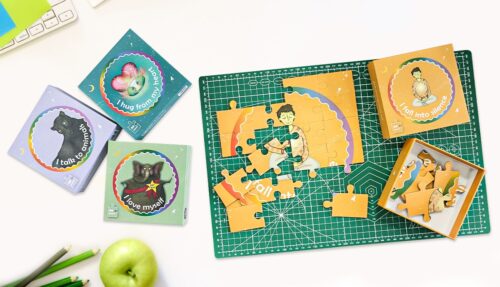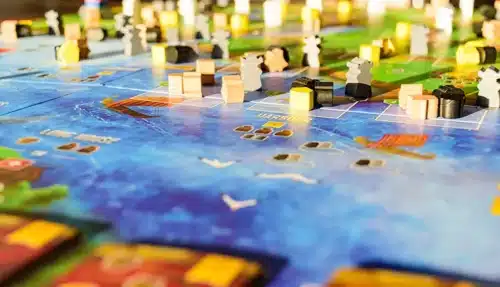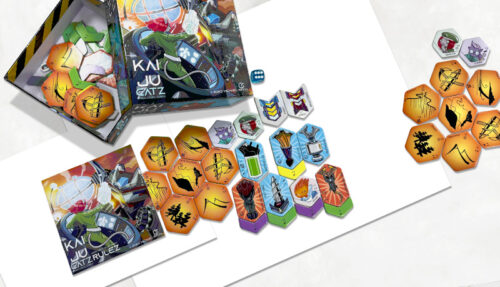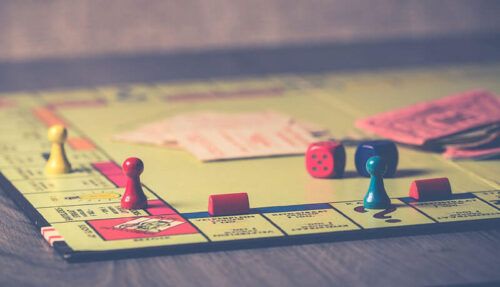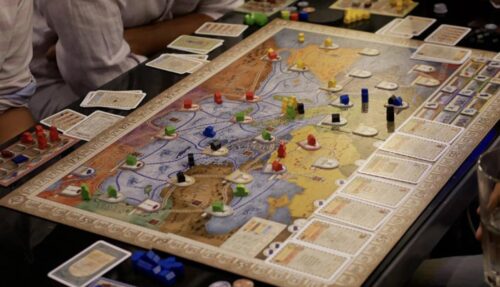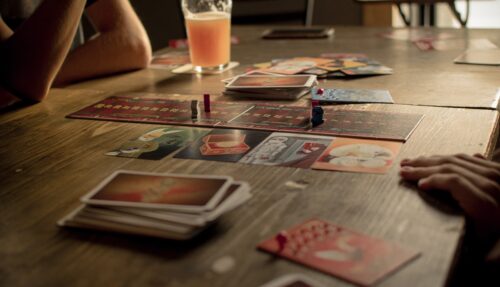A complete guide to all the components and other elements that you might want to include in your board game and how they interact to make the game fun
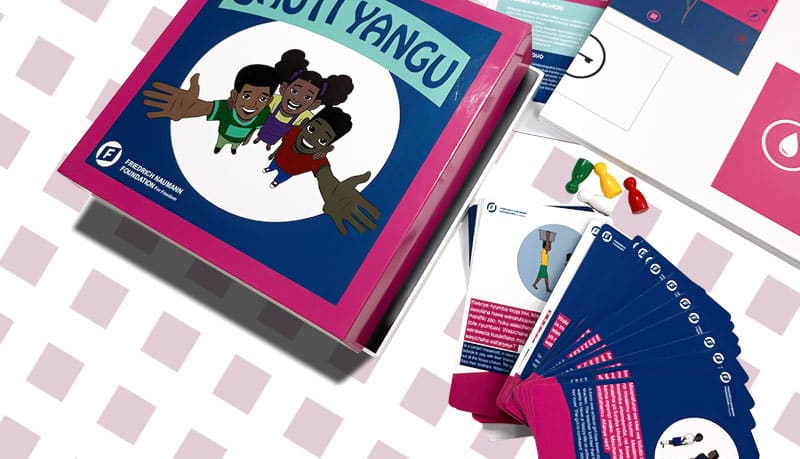
When you start researching how to make your own board game, often one of the first things that strikes you is just how many different bits and pieces — from dice and cards, to counters, coins, miniatures, and more — make up a game. In other words, there’s a lot more to it than just a board! And as you develop your idea and theme and choose the mechanics — given how many options there are to consider — you’ll need to ask yourself, “What should a board game include?“
It can quickly get confusing if you’re new to game design, even if you’ve been a keen player for a while and so have a good familiarity with a range of game styles and genres and the various elements that contribute to the uniqueness of each. So we’d like to run through the most common and popular components—as they’re called in the industry—from which you can choose what you need for your own custom board game. Several of them will be familiar to you already. Others, you may not have heard of until now. Equally, you may also invent new components that are needed for your custom design but which don’t already exist.
Before we dive into the list, we’ll just remind you that the professional collective noun for all the many bits and pieces — including the board itself, whether flat, folding, or modular — that make up a tabletop or board game is “components”. So, that’s the term we’ll use from now on.
Many of the names for the various components that can go into a board game are generic. In other words, for example, symbolic figurative pieces which represent players (like the little colored people in Carcassonne, the woodland creatures in Everdell, and even the score-keeping rabbits in Dixit) are all known as ‘meeples’. All solid geometric shapes with numbers or percentages on their surface which are rolled to obtain a random score are called ‘dice’ — singular, ‘die’ — regardless of how many sides they have. And all realistic, molded character pieces — whether people, dragons, monsters, animals, or anything else — are called miniatures.
What should a board game include? A list of all the key components you may need
So, for reasons we’ve just explained, to make things easier for you, and as this is a general guide to board game components, we’ll stick to the generic definitions for now. Obviously, not all board games need to include all of these components, even if some — like the board! — are essential by definition. In many ways, the question, “What should a board game include?” might be rephrased as, “What could a board game include?” And that’s what this list is about. Once you have a good grasp of the various possibilities and how they might interact in a live game situation, you can pick and choose, mix and match, to make a combination that’s ideal for your own board game design idea. Let’s dive in!
A gaming board

If we’re talking about board games—and we are!—then it seems logical to start with the concept of a game board, right? There’s a subtle distinction to note, however, between tabletop games and board games, even though the terms are sometimes used interchangeably. Strictly speaking, you don’t need a board for a tabletop game — just a tabletop. So, card games, paper-and-pencil games, and many puzzle games are all tabletop games but not board games. Whereas a board game must have a board of some kind. You could argue that board games are a subset of tabletop games as boards are almost always placed on a tabletop (although they’re often played on the floor, too).
The traditional and most common board for games is a printed card stock square or rectangle which may also fold up. Think popular family games like Clue or Monopoly, for example. In most cases, the board goes in the middle of the playing area and has directional sides at which players sit while there can also be more than one player per side (such that, with two players per side, a traditional four-square board could accommodate up to eight players). Other types of game board include modular sections which fit together — a bit like a jigsaw — to form the playing area. In several games — especially of the role-playing variety — the sections are placed on the table one by one as the game progresses and the configuration may change with each game played.
Also, there’s no need for a board to be square. Boards may be round, oval, triangular, hexagonal… any shape that works with your game, makes sense with your theme, and is still practical to play. So, while you should think carefully before rejecting the traditional rectangular board for reasons of ease of production and economy, it’s always worth exploring other creative options that could add an extra dimension and appeal to your custom game design.
Game cards
Cards are a common and very old component of many games. In fact, when you look into the history of playing cards, you soon discover that they appear to have originated in China sometime before the 10th century AD. Unfortunately, none of the original cards have survived and we only know about them because they are mentioned in ancient Chinese texts from the time.
Modern game cards are usually rectangular and about the size of the traditional ‘poker cards’ but may vary in size and shape. Most are made of laminated printed card stock. They can represent characters, powers, numbers, or contain instructions, penalties, bonuses, and more besides.
Game cards may be pictorial, symbolic, numerical, textual, or all three. They’re usually gathered into decks and a core function is to introduce randomization into the mechanics of a game; giving the players the opportunity to respond creatively to new situations, opportunities, and consequences. They can also be part of the ‘win condition’ of a game — for example, when to win a player must collect a full set. Other ways to use cards is to allow players the opportunity to build powers and abilities so they can increase their chances of success.
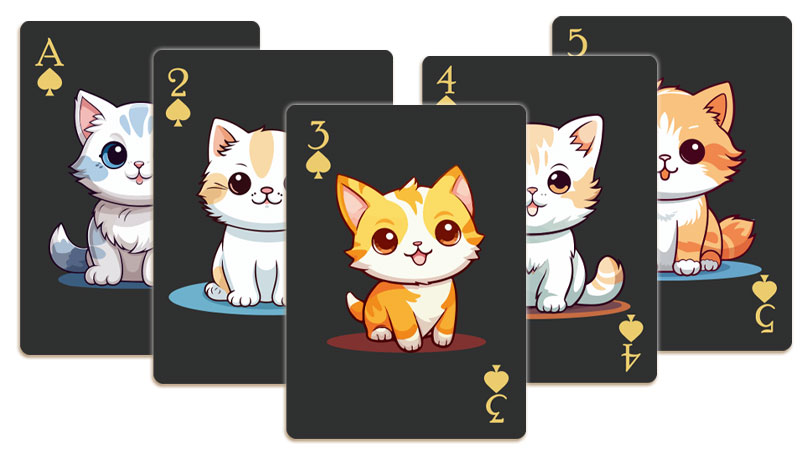
Chips, chits, coins, and counters
We’ve grouped these components together because they’re all part of the same ‘family’ or generic type. The differences between them are defined mostly by their functions within a game even though they may share very close, even identical, physical characteristics. As board games developed after traditional card games like poker, bridge, and whist, many of the oldest components were borrowed from these earlier games. These four all trace their ancestry back to the poker games played by gamblers in the saloons and casinos of the Old West.

Chips
Still used in poker as betting pieces representing cash values, chips are small round pieces about the size of a half dollar. In board games they are more commonly made of plastic these days, but may also be cardboard, metal, or even glazed ceramics. Chips usually represent a value or currency system in a board game and may have numbers or other symbols printed or stamped on them and can be different colors.
Chits
Chits are very similar to chips but made of cardboard. They’re usually printed on a single sheet of covered, perforated card stock and need to be pressed out before you can play. They can represent anything from players to currencies, to powers, skills, scores, and more.
Coins
The poker-based origins of coins are obvious. And in board games they still represent money — like the gold-colored ‘doubloons’ in Pirate‘s Cove —but are more commonly made of cardboard or plastic. That said, game manufacturers such as ourselves can also offer separate upgrades which include metallic coins. Of course, during the development phase, you can just substitute them with a pocketful of pennies and dimes if you’d like a shortcut to the ‘real feel’ of your game currency. Coins may be deployed in a game as a straightforward exchange system to allow players to obtain the resources they need to win. Likewise, they can be part of the win condition, and objective in their own right. Other options are also possible. It’s up to you, your game idea, and your imagination!
Counters
Small, flat disks, typically circular in shape, made of cardboard or plastic — although sometimes of wood or ceramics — that are used to track movement across the board. Think of Ludo, Checkers, and Backgammon as classic examples. They can also be used to keep scores or limit moves.
Dice, spinners, and other random number generators
Most board games that we manufacture for our clients have mechanics that work by a mix of chance and strategy. The oldest and most efficient way of introducing a controlled element of chance is to use a random number generator. Okay, so in the strict mathematical sense, dice and spinners aren’t completely random but they’re close enough for most board games. Otherwise, you can actually use a genuine random number generator (RNG) as an app on your smartphone or tablet. But let’s look at the most common and useful options.

Dice
Dice are geometric solids—traditionally cubes—with numbers or percentages on the sides which players roll to get a score. The classic die (singular of dice) has six sides, with the numerical values indicated by a number of dots. But modern dice can have up to 20 sides.
They’re identified by using the prefix ‘D’, followed by the number of sides. So, for example, a D6 is the classic die, a D4 is a pyramid-shaped die with four sides, and a D20 is made up of twenty triangular sides. There’s another variation commonly used in role-playing board games, which is the ‘percentile’. It’s actually a pair of special D10s with values 0 to 9, which combined give you a ‘tens’ figure and a ‘units figure’, resulting in a percentage. So, if you roll a 3 and a 0, you score 30%.
Dice-generated scores are often used to determine movement, in selection processes, in resolving combat situations, and determine rewards, for example. You may find other uses for them. Several games have a variety of dice types which are used for specific purposes within the game or combined to generate more complex outcomes.
Spinners
An even older way of generating a number in a board game is the spinner. Usually, a flat polygon spiked on a short, pointed stick — like an old-fashioned spinning top — which is twisted quickly and released to make it spin. As it loses momentum, it falls on a random side where a value is printed. Another kind of spinner is like a clock with a freely moving ‘hand’ on a central axle and the numbers spread around the perimeter. Players spin the hand and read the number closest to where it stops.
Variations on numeric dice
While most dice, whatever the number of sides, have numeric significance, you needn’t always have numbers on them. Several excellent games use dice with stickers or symbols which represent actions or characters, directions and objectives, or places, for example. So, as well as being used to decide how many spaces a character can move in a turn or the outcome of combat, they can also decide what actions a player should take or even whose turn it is next. So, when you’re designing your own custom board game, don’t allow the traditional range of components, such as dice, to restrict your creativity. There are probably endless ways you can run with each concept once you engage your imagination and based on the particular needs and mechanics of your game.
Meeples, miniatures, pawns, and standees
Meeples, miniatures, pawns, and standees are all “pieces” or substitutes for players that move around the board to achieve whatever is the objective of the game. While clearly similar in function, they have distinct forms and origins. Which you choose may depend on the theme and feel of your game, your design skills if you’re planning them from scratch, your budget (a wooden “silhouette” meeple will cost less than a realistically detailed 3D-printed or injection-molded Dungeons & Dragons or Warhammer style miniature, for example). But now let’s examine each in turn.
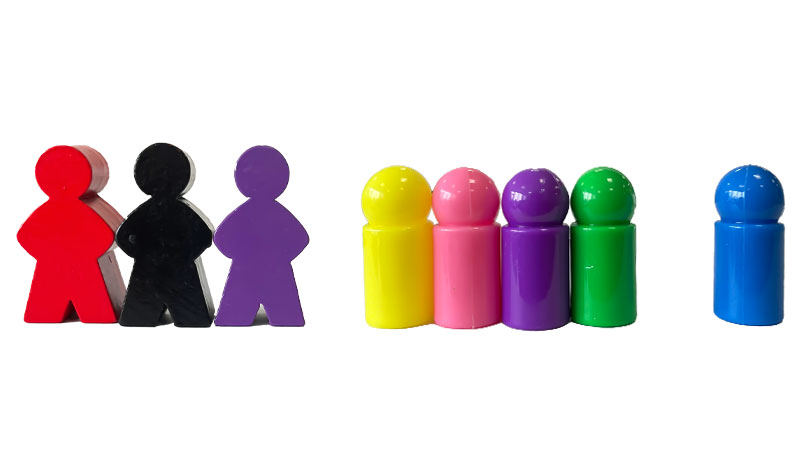
Meeples
The word ‘meeple’ entered the English language in the year 2000 when — so the story goes — a player, Alison Hansel, coined the term to describe the little wooden figures in the popular board game Carcassonne, created by German game designer, Klaus-Jürgen Wrede. It soon caught on among gamers — although it hasn’t yet found its way into the Merriam-Webster dictionary.
While strictly belonging to the original game, the term meeple is often used for any small, simple, wooden piece which represents a player in a board game. It’s also become so popular that you can find meeples as memes on social media and even on merchandise such as T-shirts, postcards, and mugs! It’s said to be a contraction of two words, ‘my’ and ‘people’.
Miniatures
The realistic molded figures — like tiny, detailed sculptures — that have their origins in war games and role-playing games, are called ‘miniatures’. So, perhaps confusingly, are scenic objects such as houses, landscape elements, fences, and other structures; but here we are talking about figurines, usually representing people, monsters, mythical creatures, animals, and soon.
While these originated with RPGs, board games have evolved and developed, both in emerging complexity and synthesizing elements from other gaming traditions, and so miniatures have migrated into board games, too. Even so, miniatures are still most commonly used in board games which are inspired by the classic role-playing games such as Dungeons & Dragons or RuneQuest. They can represent player characters who may be wizards, elves, dwarves, knights, and so on; or they can be used for monsters, dragons, and other non-player characters. Usually, both.
In war games—whether historical, fantasy, or science fiction inspired—a single miniature may stand in for a squadron, battalion, or other military unit or represent a single soldier. In a role-playing-based board game, a player will usually control a single miniature as their character. In a war game, dozens or even hundreds of miniatures may be operated by a single player.
Miniatures are made of injection-molded plastic and usually lovingly painted by the game owner. Serious hobbyists also enjoy customizing their miniatures by cutting, swapping, and adding parts. Others may collect and display miniatures as a pastime in its own right as well as deploying them on the game board.
Pawns
Pawns are at the other end of the range to miniatures, being so completely simplified as to have become wholly symbolic. Even a flat meeple looks like a person or an animal or whatever. They are best known as the first line of attack and defense in the game of Chess — are small pieces which are typically conical in shape with a flat base and a rounded ‘head’. Pawns, like meeples and miniatures, represent players on the board. They’re often made of colored plastic like the pawns in the popular detective board game, Clue.
Standees
Standees are three-dimensional game components made by slotting a press-out cardboard shape into a plastic, wooden, or metallic stand (hence the name). They usually represent players and non-player characters. But they can also be used for scenery, obstacles, and other components of certain games.
Tiles
Typically squares — but sometimes triangular, hexagonal, or other shapes — tile is a confusing term because it can refer to a kind of chip — like the letter tiles in Scrabble — or modular elements of a board with multiple possible configurations emerging during the course of play. As an example of the latter, we can reference Carcassonne again, in which the tiles are placed to form territories which the players’ meeples then occupy. So, the meaning of this term is somewhat imprecise. But, you know one when you see one!

Egg timers and 'pingers'
In several board games you may want players to work ‘against the clock’, either competitively or cooperatively. This time limitation might apply to a turn, a round, a phase, or a whole game. The traditional timer is the hour-glass with sand, or a suitable substitute, inside, which measures a minute or two as the sand slips from the upper bulb to the lower one once the timer is flipped over. Other types are those commonly used in kitchens, usually clockwork with a ticker and a bell when the time’s up — hence the name ‘pingers’ because of the tinkling bell sound they make. Obviously, there’s no reason why timed elements of the game shouldn’t be measured using any countdown device, including the one on your phone. But if it’s included as a component inside the game box, the timer is usually of the hour-glass variety as it’s lighter and less expensive.
The rulebook
Is a rule book a component? We think so. After all, without it, you can’t play the game! Rule books can be as simple as a foldout sheet or as complex as a hardcover volume with hundreds of pages; even several such volumes in the case of role-playing games. But for most board games of average complexity — and rule books should always be as simple as possible — a printed brochure or booklet is usually enough. It should be illustrated and nicely laid out with numbered headlines, sub-headings, bullet points, summary boxes, and an index to make it easy to use and quick to consult when learning the game or in case of a dispute between players. If you’re interested in finding out more about how to design a rule book for a board game, then read, How to Write a Board Game Rule Book.
It's your turn!
Well, that’s our guide to the most popular, useful, and therefore, common game components. We hope it helps get you thinking about which bits and pieces would be the best fit for your own custom board game design and answers your question about what should a board game include. It will all depend on your idea, theme, and core mechanics, but this list should get you off to a good start. Bear in mind that there are several other options not listed here, but most are variations on these main generic types. Also, some of the terms are interchangeable, so that, for example, one person’s ‘counter’ is another’s ‘chip’ and vice versa.
Did you know that here at Qin Printing we print game boards and manufacture components and custom game boxes for people just like you who want to develop their own unique game or game prototype? Among our clients are individuals with a passion project, clubs and game societies, and budding entrepreneurial game designers who need a professional version of their game to take to trade fairs, conventions, and pitch to game publishers.
If you’re interested in making your own board game, why not talk to us? We have decades of experience in the industry, state-of-the-art technology and a worldwide reputation for excellence. We’d be more than happy to discuss your ideas with you, answer your questions, and offer what advice you might need. Get in touch today and one of our friendly, expert team members will be delighted to explain how we can help or, if you’re ready, give you a quote for realizing your own beautiful, custom-made board game. Shoot us an email to [email protected] or call us on +1 226 789 2909 (remembering potential time zone differences!) and we’ll be delighted to discuss your needs, answer your questions, and help in any other way we can.






